MPPSC Mains 2021 Paper III
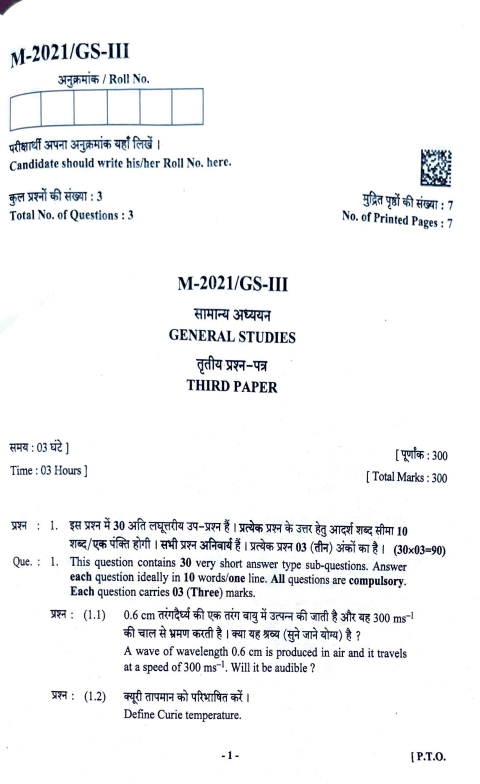

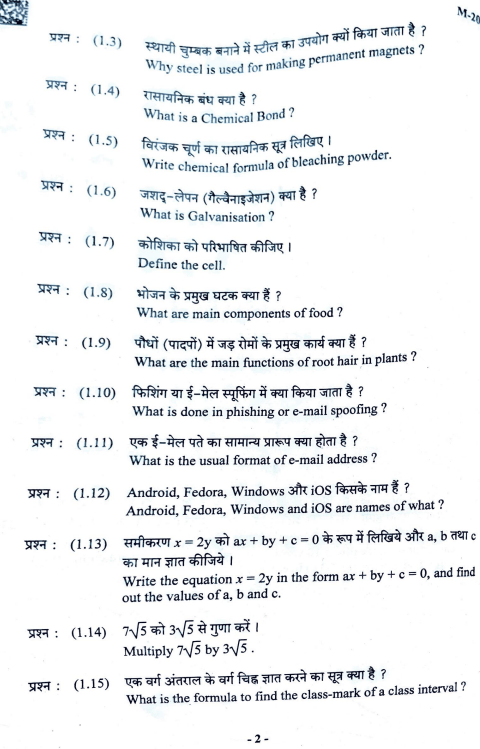

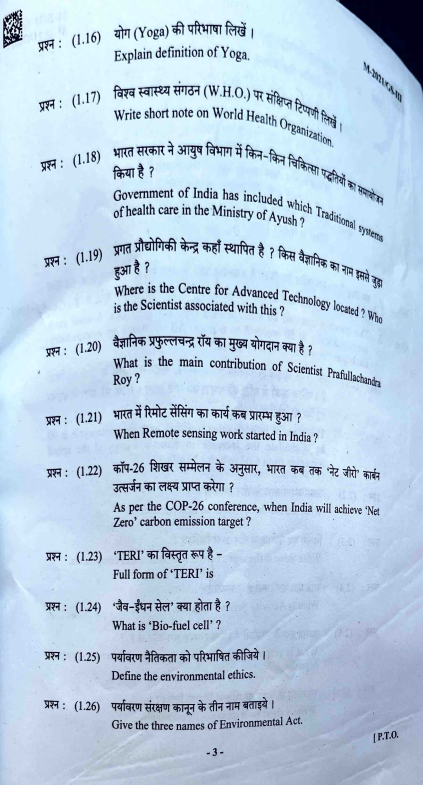

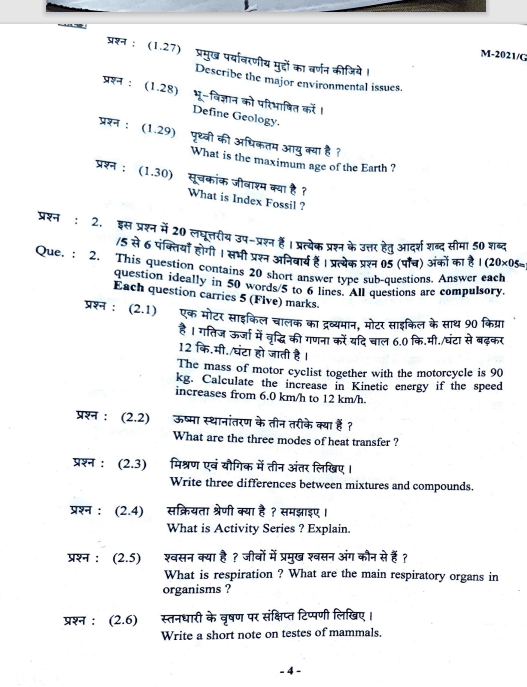

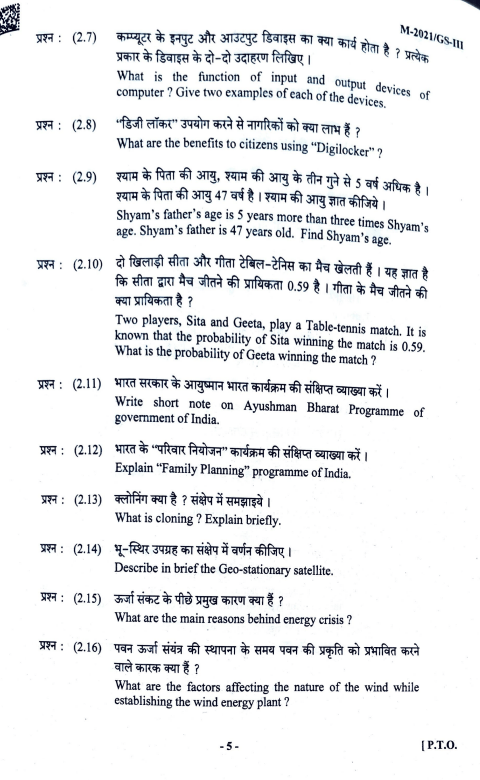

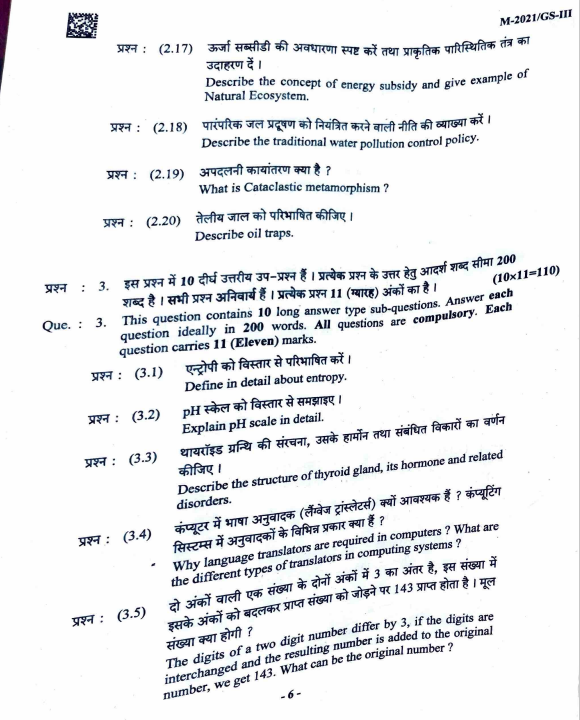




The mass of motor cyclist together with the motorcycle is 90 kg. Calculate the increase in Kinetic energy if the speed increases from 6.0 km/h to 12 km/h.
दिए गए जानकारी के आधार पर, हमें किनेटिक ऊर्जा में वृद्धि की गणना करने के लिए प्रारंभिक और अंतिम गतिज ऊर्जा का पता लगाना होगा, और फिर इनके अंतर को निकालना होगा।
दिया गया है:
मोटरसाइकिलिस्ट और मोटरसाइकिल का भार (m) = 90 किलोग्राम
प्रारंभिक गति (u) = 6.0 किमी/घंटा
अंतिम गति (v) = 12 किमी/घंटा
सबसे पहले, हमें गति को किमी/घंटे से मीटर/सेकंड में रूपांतरित करना होगा क्योंकि किनेटिक ऊर्जा के सूत्र को मीटर प्रति सेकंड में गति के अनुसार दिया गया है।
1 किमी/घंटा = 1000 मीटर / 3600 सेकंड ≈ 0.278 मीटर/सेकंड
प्रारंभिक गति (u) = 6.0 किमी/घंटा × 0.278 मीटर/सेकंड = 1.67 मीटर/सेकंड
अंतिम गति (v) = 12 किमी/घंटा × 0.278 मीटर/सेकंड = 3.33 मीटर/सेकंड
अब, आइए प्रारंभिक और अंतिम गतिज ऊर्जा की गणना करें:
प्रारंभिक गतिज ऊर्जा (K1) = (1/2) m u^2
K1 = (1/2) 90 किलोग्राम (1.67 मीटर/सेकंड)^2
K1 = 1/2 90 किलोग्राम 2.79 मीटर^2/सेकंड^2
K1 = 125.55 जूल
अंतिम गतिज ऊर्जा (K2) = (1/2) m v^2
K2 = (1/2) 90 किलोग्राम (3.33 मीटर/सेकंड)^2
K2 = 1/2 90 किलोग्राम 11.09 मीटर^2/सेकंड^2
K2 = 498.96 जूल
अब, गतिज ऊर्जा में वृद्धि (ΔK) अंतिम और प्रारंभिक गतिज ऊर्जा के अंतर को निकालने है:
ΔK = K2 - K1
ΔK = 498.96 जूल - 125.55 जूल
ΔK = 373.41 जूल
गतिज ऊर्जा में वृद्धि लगभग 373.41 जूल है।
To calculate the increase in kinetic energy, we need to find the initial and final kinetic energies and then find the difference.
Given:
Mass of the motorcyclist and motorcycle (m) = 90 kg
Initial speed (u) = 6.0 km/h
Final speed (v) = 12 km/h
First, we need to convert the speeds from km/h to m/s since the kinetic energy formula requires the speed in meters per second.
1 km/h = 1000 m / 3600 s ≈ 0.278 m/s
Initial speed (u) = 6.0 km/h × 0.278 m/s = 1.67 m/s
Final speed (v) = 12 km/h × 0.278 m/s = 3.33 m/s
Now, let's calculate the initial and final kinetic energies:
Initial kinetic energy (K1) = (1/2) m u^2
K1 = (1/2) 90 kg (1.67 m/s)^2
K1 = 1/2 90 kg 2.79 m^2/s^2
K1 = 125.55 joules
Final kinetic energy (K2) = (1/2) m v^2
K2 = (1/2) 90 kg (3.33 m/s)^2
K2 = 1/2 90 kg 11.09 m^2/s^2
K2 = 498.96 joules
Now, the increase in kinetic energy (ΔK) is the difference between the final and initial kinetic energies:
ΔK = K2 - K1
ΔK = 498.96 joules - 125.55 joules
ΔK = 373.41 joules
The increase in kinetic energy is approximately 373.41 joules.
2.2 ऊष्मा स्थानातरण के तीन तरीके ?What are the three modes of heat transfer?
The three modes of heat transfer are:
Conduction: Conduction is the transfer of heat through a solid material without the movement of the material itself. In this process, heat is transferred from a region of higher temperature to a region of lower temperature by the collision of particles (atoms or molecules) within the material.
Convection: Convection is the transfer of heat through the movement of fluids (liquids or gases). When a fluid is heated, it becomes less dense and rises, carrying heat with it. Conversely, cooler fluid becomes denser and sinks, creating a continuous circulation of heat.
Radiation: Radiation is the transfer of heat through electromagnetic waves, such as infrared radiation. It does not require any medium for heat transfer and can occur even in a vacuum. All objects emit and absorb radiation, with the amount of radiation depending on their temperature.
संधारण (Conduction): संधारण एक ठोस पदार्थ में ताप का प्रवाहन है जिसमें पदार्थ की खुद की चलन की आवश्यकता नहीं होती। इस प्रक्रिया में, उच्च तापमान वाले क्षेत्र से कम तापमान वाले क्षेत्र तक ताप का प्रवाह होता है, जिसमें पदार्थ के कण (परमाणु या अणु) आपस में टकराते हैं।
संवहन (Convection): संवहन ताप का प्रवाहन तरल पदार्थों (द्रव्य) के गतिविधि से होता है। जब कोई तरल पदार्थ गरम होता है, तो उसकी घनत्व कम हो जाती है और वह उच्चाधिकारी दिशा में ऊपर उठता है, जिससे ताप का सम्मान होता है। उसी प्रकार, शीत तरल पदार्थ घना होता है और वह नीचे गिरता है, जिससे ताप का चयन होता है। इस प्रक्रिया में, ताप यात्रा तरल द्रव्य के साथ संवहन से होता है।
विकिरण (Radiation): प्रकाशन ताप का प्रवाहन विद्युतचुम्बकीय तरंगों के माध्यम से होता है, जैसे कि इंफ्रारेड ताप। इसमें किसी पदार्थ की आवश्यकता नहीं होती है और यह वैक्यूम में भी हो सकता है। सभी वस्तुएं प्रकाशन उत्सर्जित और उपचारित करती हैं, जिसमें उनके तापमान पर निर्भरता होती है।
मिश्रण और यौगिक में तीन अंतर?
मिश्रण और यौगिक दोनों ही पदार्थों के संयोजन के उदाहरण हैं, लेकिन इनमें कई महत्वपूर्ण अंतर होते हैं। मिश्रण भौतिक रूप से अलग किए जा सकते हैं, जबकि यौगिक को केवल रासायनिक प्रतिक्रियाओं के माध्यम से अलग किया जा सकता है। मिश्रण के घटक अपने गुणों को बनाए रखते हैं और इनका अनुपात वैभविक हो सकता है, जबकि यौगिक के घटकों के गुण विशिष्ट और निश्चित होते हैं। यौगिक का संरचनात्मक निर्माण रासायनिक प्रतिक्रियाओं से होता है, जिसमें रासायनिक बंधों को तोड़ने की आवश्यकता होती है, जबकि मिश्रण का संरचनात्मक निर्माण भिन्न गुणों के वैभविक संयोजन को प्रदर्शित करता है।
सक्रियता श्रेणी ?
धातुओं की वह श्रेणी जिसमें धातुओं को उनकी क्रियाशीलता के आधार पर अवरोही क्रम में व्यवस्थित किया जाता है, सक्रियता श्रेणी कहलाती है। विस्थापन अभिक्रिया के माध्यम से विभिन्न धातुओं की अभिक्रियाशीलता का परीक्षण कर इस शैली को विकसित किया गया है। इस श्रेणी में सर्वप्रथम सबसे अधिक अभिक्रियाशील धातु को लिखा जाता है। उसके बाद मध्यम अभिक्रियाशील धातु को लिखा जाता है। अंत में सबसे कम अभिक्रियाशील धातु को लिखा जाता है।
धातुओं की उनकी क्रियाशीलता के आधार पर अवरोही क्रम में व्यवस्था (सक्रियता श्रेणी) निम्नलिखित है–
1. पोटैशियम (K)
2. सोडियम (Na)
3. कैल्शियम (Ca)
4. मैग्नीशियम (Mg)
5. ऐल्युमीनियम (Al)
6. जिंक (Zn)
7. आयरन (Fe)
8. लेड (Pb)
9. हाइड्रोजन (H)
10. कॉपर (ताँबा) (Cu)
11. मर्करी (पारद) (Hg)
12. सिल्वर (Ag)
13. गोल्ड (Au)
स्तनधारी के वृषण पर संक्षिप्त टिप्पणी लिखिए?
The testes are an essential part of the male reproductive system in mammals, including humans. These oval-shaped glands are located in the scrotum, outside the abdominal cavity, to maintain a lower temperature necessary for sperm production. The primary function of the testes is to produce sperm, the male reproductive cells, through a process called spermatogenesis.
Testes also secrete hormones, particularly testosterone, which plays a vital role in the development of male reproductive organs and secondary sexual characteristics. This hormone is responsible for the deepening of the voice, growth of facial and body hair, muscle development, and other male-specific traits.
Overall, the testes are critical for the continuation of the species, as they produce sperm required for fertilization and contribute to the expression of male characteristics in mammals.
स्तनधारी जानवरों के वृषण (टेस्टेस) उनके जीवनचक्र के लिए महत्वपूर्ण होते हैं। ये गोलाकार ग्रंथि स्क्रोटम में स्थित होते हैं, जो उनके उपांग ब्रह्मण्ड में निचली तापमान बनाए रखता है। इनमें स्पर्म का उत्पादन होता है, जिससे प्रजनन होता है। वृषण भी विशिष्ट हार्मोनों, जैसे टेस्टोस्टेरोन, का उत्पादन करते हैं, जो पुरुष विशिष्ट विकास और व्यक्तित्व गुणों के लिए जिम्मेदार होते हैं। स्तनधारी जानवरों में वृषण प्रजनन एवं पुरुष लैंगिक विशेषताओं के प्रकटीकरण में महत्वपूर्ण भूमिका निभाते हैं।
